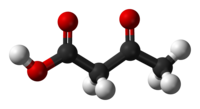
Photo from wikipedia
Ketogenic enteral nutrition (KEN™) is a modification of Blackburn’s protein-sparing modified fast, using a hypocaloric, ketogenic liquid diet. The study is about ketogenic enteral nutrition (KEN) in overweight and obese… Click to show full abstract
Ketogenic enteral nutrition (KEN™) is a modification of Blackburn’s protein-sparing modified fast, using a hypocaloric, ketogenic liquid diet. The study is about ketogenic enteral nutrition (KEN) in overweight and obese patients receiving a short treatment of the nutritional solution as a 24-h infusion. It is a retrospective analysis that examines safety, weight loss and body composition changes after three sequential 10-day cycles of KEN therapy. Anthropometric and bio-impedance data from 629 patients who underwent KEN were collected before and after completing a 10-day cycle. The study focuses on the change in outcomes from the first cycle to the second cycle and from the first cycle to the third cycle. The following outcomes were explored: weight, waist circumference, BMI, fat mass, lean mass, dry lean mass, phase angle, wellness marker, water mass as a percentage of total body weight. Statistical tests were used to test for significant differences between paired cycle 1 and cycle 2 outcomes and also between paired cycle 1 and cycle 3 outcomes. Where changes in outcomes between timepoints were found to be normally distributed, the paired t test was used, whereas where the changes in outcomes had skewed distributions, the Wilcoxon signed-rank test was used. Linear regression was used to examine associations between changes in both phase angle and BMR/weight with percentage weight change. Initially the simple relationship between variables was examined, and subsequently multiple linear regression was used to re-examine the relationships after adjusting for two pre-specified confounding variables. The results suggested significant changes for all analyzed parameters. There were significant decreases in weight, waist circumference, BMI, fat mass, lean mass, dry lean mass and phase angle. Quantitative changes in lean mass and dry lean mass were minor changes with respect to changes in fat mass. When considering the change from cycle 1 to cycle 3, there was a significant association between change in BMR/weight and change in weight, which remained significant after adjusting for changes in phase angle, fat mass and waist circumference. A one-unit increase in BMR/weight was associated with a 2.4% reduction in weight. There was no significant association between change in phase angle from cycle 1 to cycle 3 in the simple analysis. However, after adjustments greater change in phase angle was associated with a greater weight loss. KEN treatment was overall well tolerated. Results might be restricted to a British cohort only and should not be universally applied. Long-term results need to be explored in controlled studies. KEN treatment is safe, well tolerated and results in rapid fat loss without detriment to dry lean mass
Journal Title: Internal and Emergency Medicine
Year Published: 2019
Link to full text (if available)
Share on Social Media: Sign Up to like & get
recommendations!